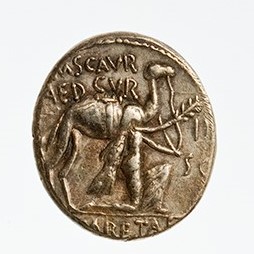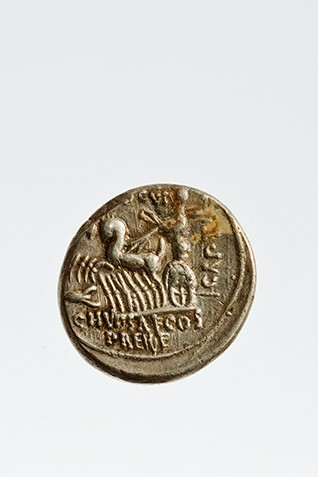Acquisition number: 1966.77
Obv.: King Aretas, draped, kneeling r., holding camel by reins in left hand, palm branch (with fillet) in right. Above, M(arcus) SCAVR(us) AED(ilis) CVR(ulis). At sides, [E]X S.C. In exergue, [REX] ARETAS.
Rev.: Jupiter in quadriga (four-horse chariot) l., holding reins in left hand and hurling thunderbolt with right hand. Below horses, a scorpion. Above, [P(ublius) HYPSAE(us) AED(ilis) CVR(ulis)]. To right, CAPTV (upwards). Below, C(aius) HYPSAE(us) CO(n)S(ul) PREIVE(rni).
Title: Denarius of M. Aemilius Scaurus and P. Plautius Hypsaeus - 1966.77
Acquisition number: 1966.77
Author or editor: Beryl Rawson
Culture or period: Roman Republic
Date: 58 BC
Material: Metal - Silver
Object type: Coins - Roman
Dimensions: 18mm (l) × 16mm (w)
Origin region or location: Italy
Origin city: Rome
Display case or on loan: 5
Keywords: Coin, denarius, Roman, Republic, Jupiter
Sear, D.R., Roman Coins and their Values 5 vols (London, Spink, 2000-2014) 379; Crawford, M., Roman Republican Coinage 2 vols (Cambridge, Cambridge University Press, 2011) 422/1b and pl. LI; Sydenham, E. A. The Coinage of the Roman Republic (London, Spink, 1952; (Sanford J. Durst repr. 1976) 913 and pl. 25; Seaby, H.A., Roman Silver Coins (London, B.A. Seaby, 1967) Aemilia 8.
1966.77
Denarius of M. Aemilius Scaurus and P. Plautius Hypsaeus
3.978 g. 58 BC
Obv.: King Aretas, draped, kneeling r., holding camel by reins in left hand, palm branch (with fillet) in right. Above, M(arcus) SCAVR(us) AED(ilis) CVR(ulis). At sides, [E]X S.C. In exergue, [REX] ARETAS.
Rev.: Jupiter in quadriga (four-horse chariot) l., holding reins in left hand and hurling thunderbolt with right hand. Below horses, a scorpion. Above, [P(ublius) HYPSAE(us) AED(ilis) CVR(ulis)]. To right, CAPTV (upwards). Below, C(aius) HYPSAE(us) CO(n)S(ul) PREIVE(rni).
This coin is important in providing a fixed date for the later Republican coinage as the Curule aedileship of Scaurus and Hypsaeus is known. Marcus Aemilius Scaurus and Publius Plautius Hypsaeus were aediles in 58 BC. Scaurus gave games of special magnificence, and on his coin glorifies an incident of his own career. This incident was in fact somewhat inglorious: in 62 BC, while on Pompey’s staff in the East, he began an invasion of Nabataean Arabia but failed to carry it through and withdrew when bought off by the Nabataean king (Aretas) for 300 talents (= 24,000 sesterces). Thus, a ‘surrender’ scene is hardly appropriate. However, it is the first instance of a moneyer publicising an event in his career on a coin.
Scaurus continued to be involved in unsavoury financial situations. In 54 BC, after his governorship of Sardinia, he was prosecuted for extortion but Cicero’s defence of him won an acquittal. He was later accused of bribery and went into exile in 52 BC. He was the stepson of the dictator Sulla (and therefore the stepbrother of Faustus Sulla, who also served on Pompey’s Eastern staff - cf. coin 67.14).
Hypsaeus uses a more traditional type to commemorate his claimed ancestor Gaius Plautius Decianus (Hypsaeus), who as consul was granted a triumph in 329 BC for the capture of Privernum (a town in Latium). ‘The scorpion recalls the ancient belief that men born under Scorpio were sackers of cities.’ (Crawford 445.)
Crawford (707) suggests that the large issue of money by these aediles may be connected with expenditure under Caesar’s agrarian law and with grain-dole expenses at this time.
This coin was one of a series revived by the emperor Trajan (cf. on 67.14), who himself conquered Nabataea in AD 106.
Sear, D.R., Roman Coins and their Values 5 vols (London, Spink, 2000-2014) 379; Crawford, M., Roman Republican Coinage 2 vols (Cambridge, Cambridge University Press, 2011) 422/1b and pl. LI; Sydenham, E. A. The Coinage of the Roman Republic (London, Spink, 1952; (Sanford J. Durst repr. 1976) 913 and pl. 25; Seaby, H.A., Roman Silver Coins (London, B.A. Seaby, 1967) Aemilia 8.

